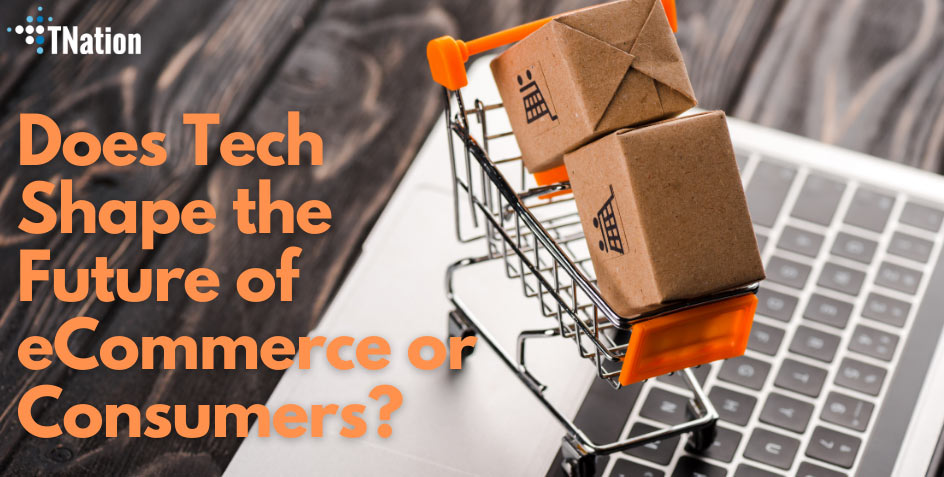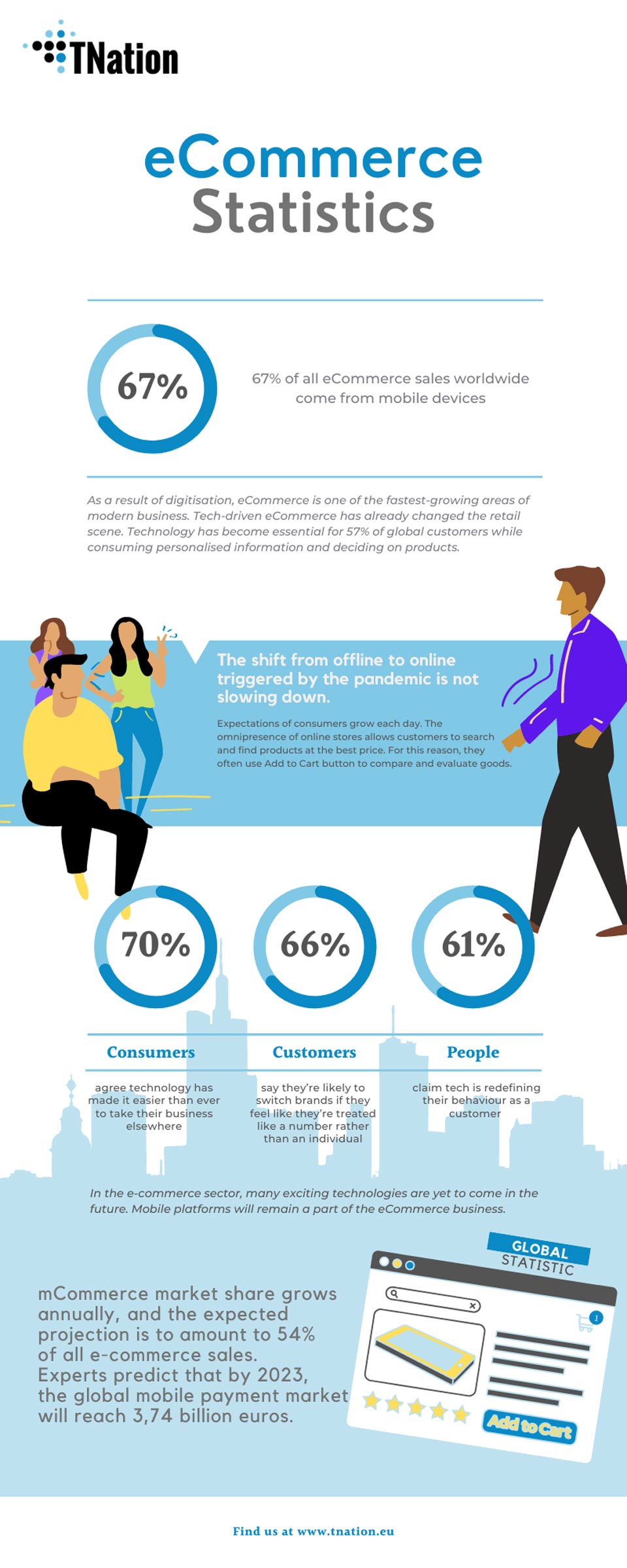New technology is influencing the birth of a re-invented retail industry. As the most popular way of shopping, eCommerce has drawn the world into a whirlwind of new experiences. The number of mobile shoppers increases daily, and eCommerce apps are widespread. With all this commotion around online shopping, what is the future of eCommerce?
Its future is no longer lingering in mobile devices because it is happening right now. More than half of the world population has a smartphone device in their hands. Many consumers shop on the go because the stores have never been closer to them. Shopping takes place literally everywhere at home or while having a lunch break in the office. There is no time limit because online shopping platforms are open 24 hours a day, fueling the convenience.
There is a certain feel of addiction in the online shopping model. Consumers sense the power of comparing prices while saving time and energy. For example, someone interested in tech gadgets can shop online for a new or discount item at a better price. Moreover, they can do it from the comfort of their home without spending time and energy. Not to mention the fascinating aspect of clicking on the “add to cart” button.
The Power of the “Add to Cart” Button
Ever since Tim Berners-Lee had an idea of the World Wide Web in the ’90s, it changed most aspects of everyday lives. Communication on a global level enabled many industries to flourish 30 years later. One of them is eCommerce (electronic commerce), which means buying and selling goods or services over the Internet.
In the beginning, electronic shopping and offline were very distinctive worlds. However, one year after the pandemic outbreak, more people found eCommerce a sanitary haven. Shopping online for groceries has become an everyday activity propelling eCommerce five years into the future. The UK is one of the leading countries in the world even today, with 39% of consumers who prefer not to go to a physical store.
In March this year, there was a global surge in online shopping. The shift from offline to online triggered by the pandemic is not slowing down, according to the latest Adobe Digital Economy Index. Their data shows that eCommerce will generate 3,43 trillion euros worldwide by the end of the year.
Expectations of consumers grow each day. Brands are using innovative ways and technology to appeal to online shoppers. The omnipresence of online stores allows consumers to search and find products at the best price. For this reason, they often use the Add to Cart button to compare and evaluate goods. However, the ultimate goal of shops is for the user to click the “Checkout” button.
As the name says, it is the most significant checkpoint in the customer journey. Even if they compare products and refine their search, consumers do not complete the purchase. There is almost 69% of the worldwide population who will abandon the cart with no second thought. Unfortunately, there is no help for organic abandonment. Still, there is a cure in the shopping cart system design to impact conversion for customers ready to buy.
Most people shift their shopping online for convenience and time-saving. Nowadays, brands compete in user experience and eCommerce app development, creating a new way of interacting with online stores. Quantity controls, remove buttons, and checkout location are of the utmost importance within the cart. Shoppers often put more items than intended as they browse if they do not have the options to navigate the cart results in abandonment easily.
Center of Retail Research (CRR) surveyed consumers in European countries. Responses show that 36% of them spend nearly half an hour comparing products before deciding to click the Add to Cart button. Some people develop a habit of hitting the Add to Cart button because of the concept that insinuates the self-reward system. In which case brain releases endorphins and dopamine, making the feeling more addictive. This claim explains that 65% of consumers claim they spend less than 16 minutes before deciding to purchase a product.
Technology is Re-inventing the Shopping Experience
The design of eCommerce apps and websites imposes the question of addictive shopping behaviour. There are 49,300,000 results on Google on the topic. The ethical design represents the challenges for the companies since a simple list of products no longer satisfies the consumers. The brands become more innovative in user experience, re-inventing the ways to help their customers.
Current technology has revolutionised the way consumers purchase online. With all the possibilities available to them, consumers have become increasingly conscious of the value of the information. They no longer passively absorb commercials and emails. Technology has become essential for 57% of global customers while consuming personalised information and deciding on products.
Shoppers are gravitating toward brands that provide additional value online. As a result, they have technology-driven experiences each day, whether their health app or product recommendation. In addition, 58% of consumers agree that technology and innovation have changed their expectations from companies. Innovation is crucial because it allows customers to experience online shopping similarly to an actual store.
This sense of browsing the products explains the popularity of “try before you buy.” Software like IKEA’s furniture app allows consumers to place a product in their own space and then decide on a purchase. Many retail firms choose to invest in a similar offline experience and develop apps that let consumers see the product in the real world. It creates a connection between offline and online shopping, an equal game-like excitement.
According to a recent global Google survey, the UK is the second-largest eCommerce market globally. 55% of British shoppers spend more time online than in-store. They pay attention to customs, taxes, and shipping times which affects their order of value.
Such little conveniences create customer satisfaction and build loyalty to the brand. Companies that embrace and welcome technology succeed because they put customer expectations at the centre of their business. In other words, consumer-centred business grows more rapidly than others. China continues to lead the global eCommerce market, with sales amounting to 2,29 trillion euros. It is also the country with 792 million digital buyers amounting to 33% of the worldwide total.

Why are Online Shopping Websites Becoming eCommerce Apps?
More than half of the world population has a smartphone. Devices are constantly connecting them to the outside world. People buy groceries, solve service issues, follow brands, and the list goes on. At the centre of the linked Internet is the mobile device. As a result, brands that fail to embrace this mobile-first mindset are falling behind their competition.
Simply put, customers expect smarter exchanges with product or service providers. The connected device creates a new way of life where each interaction or transaction happens in real-time. Consumers expect to hear the tone of their text message, email or push notification. Smartphones are becoming a command centre for buyers.
The phone centred world creates a concept of mobile eCommerce (mCommerce). Simply put, mCommerce is a natural progression of eCommerce and relies on shopping through a mobile device. Consumer reliance on smartphones predicts that mobile is slowly evolving into a preferred channel for online shopping in the next five years.
According to a Google study on global shoppers, 81% of consumers purchased over a mobile phone in the past week. mCommerce market share grows annually, and the expected projection is to amount to 54% of all e-commerce sales. Experts predict that by 2023, the global mobile payment market will reach 3,74 billion euros. In other words, it is becoming increasingly important for eCommerce stores to make their businesses responsive to all screens and devices.
What is Better to Have, an eCommerce App or Website?
The data research shows that brands with eCommerce apps achieve three times higher conversion rates than the website. The business reluctancy to adapt to the mobile world we live in lies in the price difference. Prices between the eCommerce website design and eCommerce app development are immensely distinct.
- eCommerce app development costs between 8,000 and 200,000 euros in Serbia, depending on its complexity and additional value.
- eCommerce website development costs up to 50,000 euros in Serbia, depending on complexity.
Many business owners believe that the mobile website performs equally well because it is optimised and scaled for mobile devices. However, the statistics of eMarketer concluded that users spend more than 90% of their mobile time on apps instead of the mobile web.
Consumers are looking for quick and easy solutions. Website design plays an essential role in user experience, but so does speed. If the website loads more than 2 seconds, most customers will abandon the intention and take their business elsewhere. On the other hand, apps perform much more smoothly and take less time.
Well designed and built eCommerce app stores data locally on mobile devices, in contrast to websites using web servers. That is to say that data retrieval happens swiftly in mobile apps. Apart from that, everyone has a mobile phone at hand all the time in any place.
Foretelling Future of eCommerce
The seemingly unstoppable growth of eCommerce, customer experience, digital mannequins, and robot home delivery are just some elements that will shape online shopping. But, if we examine the shift in shoppers’ behaviour and expectations after the pandemic outbreak, the entire eCommerce comes down to consumers’ expectations.
There is no doubt that mobile shopping will continue to grow. Users are increasingly aware that the online world has more to offer than the first store they stumble upon. Determination and confidence are evident in the increase in shopping outside the home country. In the last six months, 57% of consumers purchased in overseas stores.
Ease of access and the ability to distort reality is something online shoppers expect. However, returning to the digital stores after the pandemics will represent a challenge for businesses. Accustomed to digital experience, shoppers, especially millennials, are less likely to return to physical stores.
Convenience is the reason many big brands invest in customer experience. But, although it may seem like something we see in the movies, the storefronts as we know them will never be the same ten years from now. Similar to futuristic movies, industry experts predict interactive screens on shop windows and robots inside the stores.
Since many consumers use eCommerce apps while in the physical store, the borders between the digital and physical will slowly fade. As proven, immediate satisfaction of consumers needs will have become more critical by 2030. Even at this moment, consumers are less keen to wait for their order for several days. In the end, the most crucial factor of user experience is the consumer and not Technology.

Shopping Experience Centered around Specific Consumer, not Technology
The world is undoubtedly striving for the vision of smart cities. These require Technology for connectivity, storage to management and lastly, experience. It seems like eCommerce systems are on the path to an intelligent industry and influence the future of software development.
Models that tap into consumers’ needs are the future of eCommerce. Behind it is Technology that evolves at such an alarming pace that it becomes difficult to keep up with all the progress. Every business striving for success should consider current Technology’s outcomes and prepare for future eCommerce solutions.
TNation is a software development company with years of experience in eCommerce app development and custom web software development. Let us know if we can help you in any way.



